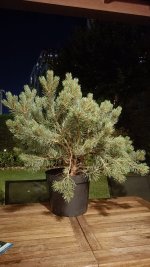early to mid Summer is a good time to prune pines. It does not matter if you are just decandling (remove new growth) or cutting back harder to oldest needles. If it is early enough the new buds will sometimes open into new shoots but the shoots will be small so ideal for making good bonsai branching. Many single flush pines will just form new buds which will not open until next Spring. That's still a good result because you are getting shoots back where they are needed.
Pruning both single flush and dual flush pines later in Summer usually results in the same - new buds that don't open until Spring.
Pruning later in Autumn and Winter can result in delayed buds but they will almost always form as the trees come out of dormancy in Spring then continue to grow and open as normal.
So Summer is a good time but most of the year is a good time to prune pines in many places.
I generally do a whole tree in one go. The tree is young and healthy and can cope with losing quite a lot of foliage no problem.
If you just prune part of a tree the parts you have not pruned tend to take all the food and energy which can starve the pruned parts and reduce bud formation. If you plan to only prune part of the tree I would do the entire top part as that's usually the dominant, strongest part. Pruning the bottom branches while leaving top to grow can lead to low branches dying.


